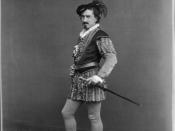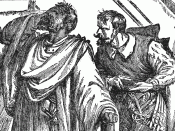Color Imagery in Othello
Imagery, as defined by Webster's Dictionary, is the use of vivid figurative language to represent objects, actions, or ideas. In Othello, Shakespeare makes use of colors to represent ideas or to set the mood for the scenes taking place. The use of such color imagery enhances the play, causing the reader to look past the mere words and search for the deeper meaning behind the scenes. The predominant colors that Shakespeare makes use of are black and white; however, some symbolism is portrayed through the use of green and red also.
Throughout history, the color black has always been used to set the mood for evil and deceit. In Othello, Iago, the antagonist, construes most of his evil plans in the dark of night. The play even opens at night as Iago begins his wicked scheming (1.1). The play also ends at night as Othello smothers his innocent wife and, later, kills himself.
In a soliloquy, Iago declares "When devils will the blackest sins put on,/They do suggest at first with heavenly shows,/As I do now" (2.3.315-317) and finishes with "So will I turn her [Desdemona] virtue into pitch" (2.3.324) This speech, using the symbolism implied by the color black, allows Iago to make known his malicious intents. Convinced, through Iago's scheming, of Desdemona's impurity, Othello proclaims that "her name, that was as fresh/As Dian's visage, is now begrim'd and black/As mine own face" (3.3.387-389).
Shakespeare's main character is the black Moor Othello. Here, black is not used to imply a sense of evil. In one aspect, it reflects the racism during the times of Shakespeare. Using a black character allows Shakespeare to put racial tensions into his play, placing an even greater weight upon the rifts that are created among the other characters.
![From the Library of Congress: TITLE: Thos. W. Keene. Othello CALL NUMBER: POS - TH - 1884 .O7, no. 1 (C size) [P&P] REPRODUCTION NUMBER: LC-USZC6-58 (color film copy transparency) RIGHTS INFORMATION: No known restrictions on publication. MEDIUM: 1 print (](https://s.writework.com/uploads/9/94760/library-congress-title-thos-w-keene-othello-call-number-pos-thumb.jpg)


Use of the colour red
very good use of your text and well written! my only criticism was i felt you were grasping for examples in the colour 'red' section: roses can be white, yellow, pink, orange and Othello does not specify the colour. doesn't he mention Desdemona's red lips somewhere in the text? that would be more appropraiate as it has connotations with lust and temptation etc. well done.
1 out of 1 people found this comment useful.